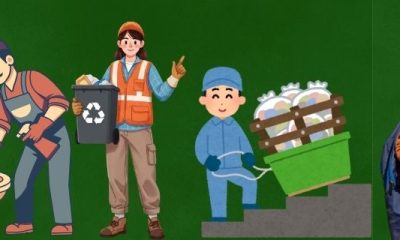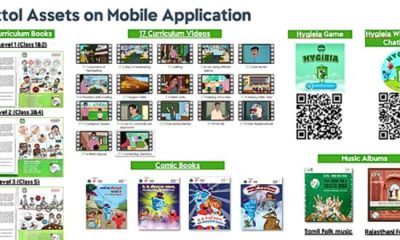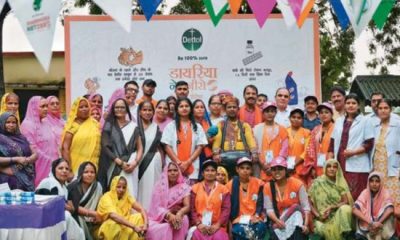New Delhi: Rachna’s evenings were packed. She would walk around on beaches collecting waste and discarded materials from Saral beach in Alibaug, Maharashtra. And what next? She put together all the waste and converted it into art – There Is No Such Thing Called Waste. From plastic, wood, ropes to coir, to create dozens of art objects, tapestries and sculpture, Rachna collected waste material with the help of Mumbai’s Naari Shakti Self Help Group (SHG). Talking about her work, she said,
We made tapestries, textiles, sculptures, etc. All the material was collected from the beach and consisted of fishnets, thermocol, polytherian, nylon ropes, fabric, plastic bags, plastic sheets, plastic garlands. I wanted to show people what we throw at nature and how it affects marine health as well as the health of people living around the beach. Additionally, most of the materials that were thrown in the beach could be reused and recycled and can be kept in loop for a long time.
Also Read: Art For A Cause: How 3X Grammy Winner Ricky Kej Is Creating Music For A Healthier Planet
Through her artwork, the Mumbai-based environmentalist and artist, Rachna Toshniwal drew attention to ecology’s sovereignty and circular economy. It conveys the message of discarding the traditional take-make-consume-dispose method and respecting environmental boundaries by increasing the share of renewable or recyclable resources.
Manjot Kaur, a contemporary artist from Chandigarh, drew attention to ecology’s sovereignty and promoted afforestation through her artwork The Parliament of Forests. Talking about the significance of art in raising environmental issues, Manjot said,
Art has the power to visually depict the beauty of nature, the consequences of environmental degradation, and potential solutions, which can resonate deeply with audiences and inspire action. This might take time but a constant hit would eventually lead to some different actions. Art has the ability to transcend language barriers and reach diverse audiences globally, making it an effective tool for advocating for environmental awareness and social change.
Artist Debasmita Ghosh’s Living With The Land, an art installation that tracks the consequences of transitioning from traditional mud to industrial materials for constructing homes in the Kondh community of Odisha.
All the three artists exhibited their work at Sustaina India art exhibition, an initiative by Council on Energy, Environment and Water (CEEW) and multi-disciplinary artists Jiten Thukral and Sumir Tagra. The exhibition sculpted a critical connection between artworks, artists and everyday materials to realign our relationship with the planet.
Also Read: How Is Climate Change Impacting Our Health?
One of the audience to the exhibition, Abhinav, said such exhibitions are significant to increase public awareness about environmental issues like climate change and sustainability,
We have been reading about climate change and sustainability since school through textbooks. But it is rare to see one whole art exhibition dedicated to it. This exhibition definitely showcased what is happening in the world at present. Such kinds of exhibitions help in getting the conversation started around sustainability and climate change.
Co-curators of the exhibition Thukral and Tagra said,
The fellowship artists, Manjot Kaur, Rachna Toshniwal and Debasmita Ghosh, echo the vision of climate awareness. There was a need for a platform like Sustaina India, to enable artists to nudge their practice through thoughtful actions, and work around challenges to create works which are both informed and humble in mediums to learn from.
How the idea of exhibition came into being, Suyashi Smridhi, Communications Associate, Council on Energy, Environment and Water (CEEW), and co-organiser of the exhibition, said they came across Thukral and Tagra a few months ago, when they witnessed their exhibition in Delhi about air pollution.
For a long time, we’ve been trying to mainstream sustainability, but we realised that although research is significant, communicating the research has just as big a role to play, because not everybody is going to go through the report to know about climate change and sustainability. There have to be ways to reach out to the audience at a large scale.
Also Read: Climate Change And Increase In Diarrhoeal Disease – What’s The Connection?
NDTV – Dettol have been working towards a clean and healthy India since 2014 via the Banega Swachh India initiative, which in its Season 10 is helmed by Campaign Ambassador Ayushmann Khurrana. The campaign aims to highlight the inter-dependency of humans and the environment, and of humans on one another with the focus on One Health, One Planet, One Future – Leaving No One Behind. It stresses on the need to take care of, and consider, everyone’s health in India – especially vulnerable communities – the LGBTQ population, indigenous people, India’s different tribes, ethnic and linguistic minorities, people with disabilities, migrants, geographically remote populations, gender and sexual minorities. In a world post COVID-19 pandemic, the need for WASH (Water, Sanitation and Hygiene) is reaffirmed as handwashing is one of the ways to prevent Coronavirus infection and other diseases. The campaign will continue to raise awareness on the same along with focussing on the importance of nutrition and healthcare for women and children, fight malnutrition, mental well-being, self-care, science and health, adolescent health & gender awareness. Along with the health of people, the campaign has realised the need to also take care of the health of the eco-system. Our environment is fragile due to human activity, which is not only over-exploiting available resources, but also generating immense pollution as a result of using and extracting those resources. The imbalance has also led to immense biodiversity loss that has caused one of the biggest threats to human survival – climate change. It has now been described as a “code red for humanity.” The campaign will continue to cover issues like air pollution, waste management, plastic ban, manual scavenging and sanitation workers and menstrual hygiene. Banega Swasth India will also be taking forward the dream of Swasth Bharat, the campaign feels that only a Swachh or clean India where toilets are used and open defecation free (ODF) status achieved as part of the Swachh Bharat Abhiyan launched by Prime Minister Narendra Modi in 2014, can eradicate diseases like diahorrea and the country can become a Swasth or healthy India.


































